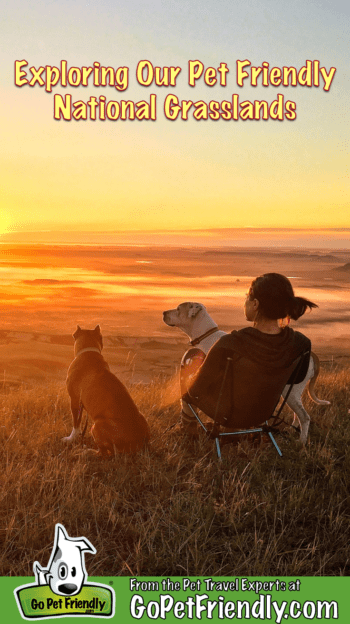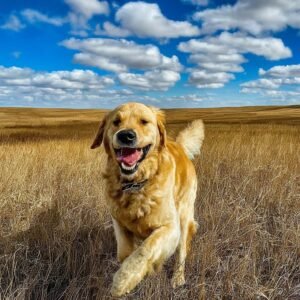America’s national grasslands certainly aren’t as popular as our national parks. But that can work to your advantage when traveling with pets! Actually, national grasslands are the perfect place to explore with your dogs.
A field of grass—uh, really? What am I supposed to do there? And, more importantly, how am I going to entertain the dogs? These were my thoughts as I scoured the map for fun pit stops on our road trip through the Midwest.
I was on the hunt for dog friendly places with room to explore on our impromptu trip. But the national and state park campgrounds were already full. So I booked a campsite at Pawnee National Grassland. And when we arrived, the dogs and I realized we’d stumbled upon a gem!
History Of America’s National Grasslands
The grasslands were originally home to native tribes and vast herds of bison, elk, and other wildlife. In the 1860s, European settlers arrived and saw these expansive prairies as prime locations for hunting and agriculture. The farmers, however, were not accustomed to managing the arid soils of the grasslands, particularly during years of drought.
Without the native grasses to hold down the thin topsoil, the dry, sandy dirt simply blew away. This triggered the Dust Bowl period of the 1930s, when 20,000-foot walls of blowing dust and sand ripped across the Midwest.
Finally, the government stepped in during the Great Depression to purchase the land from farmers. This helped the families with financial troubles and benefited the land as efforts began to restore the original ecosystem.
The national grasslands are now managed by the Unites States Forest Service. And that is great news for those of us traveling with dogs, because the Forest Service tends to be very pet friendly! They work to maintain the natural ecosystem, while making the land accessible to us all to enjoy.
National Grasslands To Visit With Dogs
There are 20 national grasslands totally almost 4 million acres across the United States. Most are located west of the Mississippi River and east of the Rocky Mountains, in an area commonly referred to as “The Great Plains.”
Visit the National Grasslands website for details on each of the grasslands listed below and the contact information for the Forest Service Ranger District managing each location.
California — Butte Valley National Grassland – California’s only national grassland, Butte Valley’s 18,425 acres are located in the southern Cascade Range in northern California.
Colorado — Comanche National Grassland – Located in Baca, Las Animas, and Otero counties southeastern Colorado, the preserve covers more than 440,000 acres.
Colorado — Pawnee National Grassland – Covers 193,060 acres in northern Colorado (35 miles east of Fort Collins).
Idaho — Curlew National Grasslands – Beginning in a wide valley near Snowville, Utah, this 47,000-acre grassland spreads in a checker board pattern of public and private land north into Idaho.
Kansas — Cimarron National Grassland – Located within Morton and Stevens Counties in southwestern Kansas, this grassland covers 108,175 acres.
Nebraska — Oglala National Grasslands – Located in northwestern Nebraska, north of Crawford, this 94,000-acre preserve is also home to Toadstool Geologic Park.
New Mexico, Oklahoma & Texas — Kiowa and Rita Blanca National Grasslands – Encompassing 230,000 acres, these grasslands are intermingled with privately-owned land in six counties within New Mexico, Texas, and Oklahoma.
North Dakota — Little Missouri National Grassland – Located in western North Dakota, the Little Missouri is the largest national grassland in America at 1,033,271 acres. In fact, Theodore Roosevelt National Park is completely encompassed within its borders.
North Dakota — Sheyenne National Grassland – The only national grassland in the tallgrass prairie region of the United States, Sheyenne covers 70,180 acres in southeastern North Dakota. It provides habitat for greater prairie chickens in North Dakota as well as several other sensitive species, like the Dakota skipper and Regal Fritillary.
North Dakota & South Dakota — Cedar River and Grand River National Grasslands – Combined, these two grasslands cover more than 160,000 acres in southwestern North Dakota, and northwestern South Dakota.
Oklahoma & Texas — Black Kettle and McClellan Creek National Grasslands – Covers more than 31,000 acres in western Oklahoma and the eastern part of the Texas panhandle.
Oregon — Crooked River National Grassland – Located within a triangle between Madras, Prineville and Terrebonne, Oregon, this 173,629-acre grassland is popular for hunting, fishing, boating, hiking, rock climbing, and OHV riding.
South Dakota — Buffalo Gap National Grassland – This national grassland is divided into two areas in southern South Dakota. One area is in the Black Hills, near Hot Springs. The other is near Badlands National Park.
South Dakota — Fort Pierre National Grassland – Extends over 116,000 acres south of Fort Pierre, South Dakota and north of Interstate 90.
Texas — Caddo and Lyndon B. Johnson (LBJ) National Grasslands are located in two areas, one to the northeast and one to the northwest of Dallas-Fort Worth. They are popular destinations for hiking, camping, fishing, hunting, horseback riding, mountain biking, wildlife viewing, and photography.
Wyoming — Thunder Basin National Grassland – Encompasses 547,499 acres in northeastern Wyoming in the Powder River Basin between the Big Horn Mountains and the Black Hills.
What To Expect
You and your dog can experience these national grasslands through a variety of activities: hiking, mountain biking, camping, fishing, sightseeing, and more. And keep in mind that these lands are more than just a field of grass! Many contain rivers, lakes, canyons, and badlands.
If you and your dog like to explore, the national grasslands are perfect as either a pit stop to stretch your legs, or spend several days enjoying.
Cool Whip, Hercules, and I explored two grasslands in particular: Pawnee and Buffalo Gap. We camped and hiked along buttes and badlands, and relaxed with some of the best sunsets and sunrises we’ve caught in a long while.
Pawnee National Grassland – Colorado
As you leave the pavement for a few long dirt roads, driving to Pawnee National Grassland feels like you’re heading into the middle of nowhere. After crossing the cattle guards (and possibly waiting for a herd of cows to mosey by), follow the signs to Pawnee Buttes Trailhead. Cresting a hill, the buttes jutting up from this otherwise smoothly flowing landscape appear suddenly. It’s almost a surprise, even when you’re expecting them.
At the trailhead, you’ll find bathrooms, picnic tables, and a sign with general trail and landscape information. Head out with your dog for a relatively easy 4-mile roundtrip hike to see Pawnee Buttes up close. Or, for a shorter hike, just walk to the viewpoint, which is about 1 mile, roundtrip.
If you’re planning to spend the night, there are several locations along the trailhead road suitable for dispersed camping. Or opt for the campground. It’s about 45 minutes away at the Crow Valley Recreation Area in the eastern section of preserve.
Buffalo Gap National Grassland – South Dakota
Buffalo Gap National Grassland wind across the southwestern corner of South Dakota in a stretched-out S-shape. The northern portion hooks around Badlands National Park and is just a few minutes from the National Grasslands Visitor Center in Wall, South Dakota.
Make a point to stop by the Visitor Center before you head into the grasslands. They can provide maps and suggestions for making the most of your visit.
This is also a great place to camp if you’re visiting Badlands National Park, but want more freedom for your dog. The views combined with the peace and quiet make for outstanding camping.
National grasslands are wonderful places to visit with your dogs — especially when you respect the rules and keep your dog under control at all times. This is not just for the safety of other visitors and local wildlife, but also for you and your dog.
The tall grasses can hide cliffs and small cacti, which you don’t want to stumble into. Also, certain areas of the grasslands are used for livestock grazing, so you never know when you’ll wake up to find a cow has stopped by for morning coffee.





